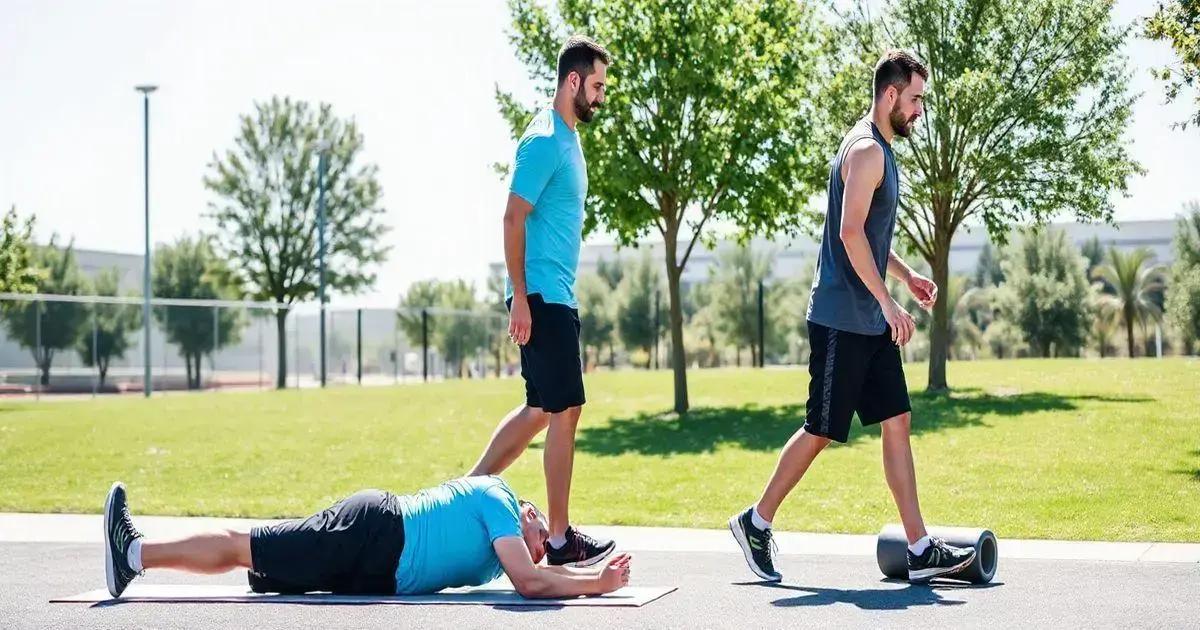The role of active recovery days in modern fitness plans for men includes engaging in low-intensity exercises to enhance muscle recovery, prevent injuries, and maintain motivation while allowing the body to heal and improve overall fitness.
Active recovery days play a crucial role in modern fitness plans for men. These days are not about complete rest; instead, they focus on engaging in low-intensity activities that promote muscle recovery and overall well-being. Incorporating active recovery into your routine can significantly enhance performance, prevent injuries, and keep you motivated on your fitness journey. In this article, we will delve into the concept of active recovery, its benefits, ways to incorporate it into your regimen, and suggest some of the best exercises to perform during these essential recovery days.
Understanding Active Recovery

Active recovery refers to low-intensity exercise performed after intense workouts. Contrary to popular belief, taking a complete rest day isn’t always the best choice for recovery. Engaging in active recovery can help improve your body’s healing process and enhance your overall fitness.
Active recovery promotes blood circulation. This increased blood flow helps reduce soreness and aids in the removal of metabolic waste produced during intense workouts. Consider activities such as walking, yoga, or cycling at a leisurely pace.
Types of Active Recovery:
- Walking: Ideal for all fitness levels and can be done anywhere.
- Stretching: Helps increase flexibility and prevent injuries.
- Yoga: Enhances relaxation and improves mental focus.
- Light Cycling: A fun way to stay active while recovering.
Another aspect of active recovery is its psychological benefits. Engaging in these lighter activities can keep you motivated and help maintain your routine without causing burnout. It allows you to enjoy exercise without the intensity of your regular workouts.
In summary, understanding active recovery days is essential for anyone focused on improving their fitness. By incorporating low-intensity activities into your schedule, you can support your body’s recovery while staying motivated and engaged.
Benefits of Active Recovery Days

Active recovery days offer several benefits that are crucial for maintaining a successful fitness routine. One of the most significant advantages is injury prevention. By engaging in low-intensity exercise, you reduce the risk of overtraining and stress injuries that often come from intense workouts.
Improved Muscle Recovery: Active recovery promotes blood flow to your muscles, which enhances nutrient delivery and accelerates the healing process. This helps reduce soreness and stiffness, allowing you to return to more intense workouts sooner.
An uplifted mood is another great benefit. Engaging in light activities can help release endorphins, which are natural mood boosters. This is especially important for men trying to stay motivated in their fitness journey.
Better Flexibility: Including stretching or yoga during active recovery days also improves flexibility. Enhanced flexibility can lead to better performance in rigorous workouts and reduce the likelihood of injuries.
Finally, actively participating in recovery days fosters a balanced fitness plan. It allows you to listen to your body and encourages a sustainable approach to fitness. By incorporating these days into your routine, you learn the importance of rest and recovery, promoting a more effective long-term fitness strategy.
How to Incorporate Active Recovery

Incorporating active recovery into your fitness routine can be simple and effective. Here are some practical steps to get started:
1. Schedule Regular Recovery Days: Plan specific days for active recovery in your weekly routine. Aim for at least one to two days a week dedicated to low-intensity activities.
2. Choose Enjoyable Activities: Select activities that you enjoy. This could be walking, swimming, cycling, or yoga. Engaging in enjoyable exercises makes it easier to stick to your recovery plan.
3. Mix It Up: Vary the types of low-intensity exercises you do to keep things interesting. Try different types of stretching, light cardio, or even recreational sports for variety.
4. Monitor Your Body: Listen to your body’s signals. If you feel tired or sore, consider reducing the intensity or duration of your active recovery activity.
5. Stay Hydrated and Nourished: Hydration and nutrition play a big role in recovery. Ensure you drink plenty of water and consume a balanced diet to support your body’s needs on these days.
6. Use Recovery Tools: Incorporating tools like foam rollers, massage balls, and stretching bands can enhance your active recovery. These tools help relieve tension and improve flexibility.
By intentionally planning active recovery days, you can maintain motivation and support your fitness goals. It allows you to balance intensity with recovery, making your fitness journey more sustainable and enjoyable.
Best Exercises for Active Recovery Days

Active recovery days are essential to any fitness program, and choosing the right exercises can maximize their benefits. Below are some of the best exercises to include on your active recovery days:
1. Walking: A simple and effective way to promote recovery. A brisk walk for 20-30 minutes can improve blood circulation without straining your muscles.
2. Yoga: Incorporating yoga into your routine helps improve flexibility and relax the mind. Focus on gentle poses that stretch and restore the body.
3. Swimming: Swimming provides a low-impact workout that is easy on the joints. Try easy laps or aqua jogging to keep your heart rate up without excessive strain.
4. Cycling: Light cycling, either on a stationary bike or outdoors, is a great way to engage your legs without putting too much stress on them. Aim for a leisurely pace during these rides.
5. Stretching: Spend time stretching major muscle groups to enhance flexibility and relieve tension. Incorporate both dynamic and static stretches into your routine.
6. Foam Rolling: Use a foam roller to massage sore muscles. This helps reduce tightness and improve recovery, making it an excellent activity for active recovery days.
These exercises are designed to keep you active while allowing your body to recover. Remember to listen to your body and adjust the intensity based on how you feel.
Embracing Active Recovery for Better Fitness
Active recovery days play a vital role in modern fitness plans, especially for men striving to enhance their performance and well-being. By incorporating low-intensity workouts and focusing on recovery, individuals can prevent injuries, improve flexibility, and boost their overall fitness.
Understanding and applying the best practices for active recovery not only aids in muscle healing but also keeps you motivated and engaged in your fitness journey. With simple exercises like walking, yoga, and light cycling, staying active on recovery days becomes enjoyable.
Therefore, consider making active recovery an essential part of your routine. It’s a strategic approach that optimizes your training results and helps you achieve long-term fitness goals.
FAQ – Frequently Asked Questions about Active Recovery
What is active recovery?
Active recovery involves engaging in low-intensity exercises on rest days to promote muscle recovery and prevent injuries.
Why are active recovery days important?
Active recovery days help enhance blood flow, reduce muscle soreness, and improve flexibility, supporting overall fitness goals.
What are some examples of active recovery exercises?
Examples include walking, yoga, swimming, cycling, stretching, and foam rolling.
How often should I incorporate active recovery days?
It is recommended to include one to two active recovery days each week into your fitness routine.
Can I do strength training on active recovery days?
It’s best to focus on low-intensity exercises. Heavy strength training should be avoided to allow the body to recover adequately.
How does active recovery help prevent injuries?
Active recovery reduces the risk of overtraining by allowing muscles to repair while still keeping the body engaged in movement.












